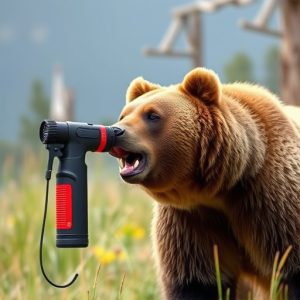Mastering Bear Spray Defense: Wind Direction & Safety Tips
Bear spray, an essential tool for safety in bear-inhabited areas, relies on capsaicin to deter aggre…….
Bear spray, an essential tool for safety in bear-inhabited areas, relies on capsaicin to deter aggressive bears. Effective usage requires understanding wind direction, aiming at the bear's face and body, and maintaining a safe distance. Key safety tips include storing and maintaining the spray correctly, being aware of its range and duration, and using it as a last resort when encountering predators. Regular practice sessions, guided by professionals, are crucial for building confidence and swift reaction times in high-stress situations, ensuring users can navigate dangerous predator encounters safely.
“In areas where wildlife encounters are common, knowing your defense options is vital. Bear spray, a powerful tool for personal safety, offers a non-lethal means of deterring aggressive predators. This comprehensive guide explores bear spray as a defensive mechanism, from understanding its chemical composition and effectiveness to mastering application techniques under varying wind conditions (Bear Spray Wind Direction Safety Tips). Learn how to choose the right spray for your environment, maintain it properly, and train to use it confidently in emergency situations.”
- Understanding Bear Spray: What It Is and How It Works
- Choosing the Right Bear Spray for Your Needs
- Proper Usage Techniques: Wind Direction and Safety Tips
- Storage and Maintenance: Ensuring Your Bear Spray Remains Effective
- Training and Practice: Building Confidence in Emergency Situations
Understanding Bear Spray: What It Is and How It Works
Bear spray, also known as bear repellent, is a crucial tool for individuals navigating wilderness areas inhabited by bears. It’s more than just a defense mechanism; it’s a sophisticated mixture designed to deter aggressive behavior from predators like grizzly and black bears. Understanding how bear spray works and optimal safety tips regarding its use, including the bear spray wind direction, can significantly enhance survival chances in these environments.
The primary active ingredient in bear spray is capsaicin, derived from chili peppers. When sprayed, it irritates the bear’s eyes, nose, throat, and lungs, temporarily disorienting and encouraging the animal to flee. Proper application involves aiming for the bear’s face and body, ensuring the spray reaches its sensitive areas. Safety tips include knowing the wind direction before spraying—it’s best to keep the wind blowing away from you, as this minimizes your exposure to the irritant. Additionally, keeping a safe distance and only using bear spray as a last resort are vital for effective and safe predator defense.
Choosing the Right Bear Spray for Your Needs
When considering bear spray as a defense mechanism, it’s crucial to select the right product tailored to your specific needs and environment. Different regions have varying bear species and behaviors, so understanding local guidelines is essential. For instance, knowledge about the predominant wind direction in your area can significantly impact spray effectiveness; always choose a bear spray designed for optimal performance against the prevailing winds.
Safety tips play a vital role in responsible usage. Bear spray should be used as a last resort when faced with an aggressive predator. It’s recommended to carry it on your person, easily accessible, and familiarize yourself with its range and duration. Regular maintenance and understanding the expiration dates are also critical to ensure its potency remains effective when needed.
Proper Usage Techniques: Wind Direction and Safety Tips
Knowing the proper usage techniques for bear spray is crucial, especially when navigating potentially dangerous predator encounters in wild environments. One key aspect to master is understanding and accounting for wind direction. When deploying bear spray, aim for the face and eyes of the approaching predator, as this can effectively deter or disable them. However, be mindful of the wind; always back away from it to ensure the spray doesn’t blow back towards you, potentially causing harm or reducing its effectiveness.
Safety tips should also be at the forefront of your mind. Always keep bear spray readily accessible and familiarize yourself with its range and duration. Before using it, make sure you have a clear escape route planned, allowing you to quickly retreat if needed. Additionally, regular practice sessions can help you become more comfortable and confident in deploying bear spray effectively during high-stress situations.
Storage and Maintenance: Ensuring Your Bear Spray Remains Effective
Proper storage and regular maintenance are key to ensuring your bear spray remains effective when you need it most. Store your bear spray in a cool, dry place, away from direct sunlight and extreme temperatures. Keep it out of reach of children and pets, as well as any flammable materials or heat sources. Regularly inspect the can for any signs of damage, corrosion, or leakage. Test the trigger and nozzle to make sure they are functioning properly. Check the expiration date and replace the spray if it’s past its prime.
When it comes to bear spray wind direction safety tips, understanding the dynamics of wind is crucial. Aiming correctly can significantly impact the effectiveness of your defense. Keep in mind that wind can blow the spray back towards you or dilute its concentration. Try to position yourself upwind of the potential threat, allowing the spray to move from you to the bear. If possible, use barriers like trees or rocks to block the return path of any airborne spray.
Training and Practice: Building Confidence in Emergency Situations
When it comes to bear spray defense, training and practice are paramount. Understanding the wind direction safety tips is crucial for effective deployment. Regularly rehearsing how and when to use bear spray builds confidence in emergency situations. Simulating various scenarios allows individuals to gauge distances, assess wind conditions, and develop a quick reaction time. This preparation ensures that when facing an actual predator encounter, one can act swiftly and decisively.
Practicing with a trained professional or through guided simulations provides valuable feedback. It helps individuals understand the spray’s range, effectiveness, and potential drawbacks. By consistently training in different settings and conditions, users become more adept at navigating high-pressure situations. This skill set not only enhances safety but also boosts mental resilience, enabling folks to remain calm under duress.
Bear spray is a powerful tool for self-defense against predators, but its effectiveness relies on proper usage techniques, including understanding wind direction and safety tips. By choosing the right bear spray tailored to your needs, storing it appropriately, and training with it, you can increase your confidence and readiness in potential emergency situations. Remember, knowledge of both the weapon and the environment is key to ensuring your safety when facing wild predators.


